You might be reading this article from your bed, staring up at your ceiling, wishing your neighbors would stop stomping around. Maybe you’re one of the millions of people who have problems with their upstairs neighbors, or maybe they have problems with you. Either way, you’ve come to the right place.
No, we’re not going to teach you how to get them kicked out of the residence. Instead, we’re going to show you how to soundproof a ceiling. After insulating your space from noises, you’ll finally be able to have a good night’s sleep.
While soundproofing a ceiling sounds like hard work, it’s actually easier than you might expect. However, some of these methods are more expensive than others but don’t worry. There’s a perfect soundproofing solution to match any budget.

Airborne vs. Impact Soundwaves
There are a wide variety of sounds that can come through your ceiling. Some are short bursts of loud noise, while others seem to drone on and on throughout the day. Determining what type of sound you’re dealing with will affect what kinds of soundproofing you need.
All sounds are generally broken into two categories: airborne or impact sound.
Here, we’ll go over the two different types of sounds so you can have a better idea of what your next steps should be.
Airborne Sound
Any soundwaves that travel through the air to reach your ears are known as airborne sounds. These sounds come from things like music, talking, crying babies, and alarms, among a plethora of other sources.
Airborne sound waves continue to travel until they come into contact with a hard object or surface. After the impact, the sounds scatter in different directions, or the material absorbs them. In this case, your ceiling can repel or absorb sound waves depending on its material.
When your upstairs neighbor plays music, and you hear it through your ceiling, that is an example of airborne sound at work. The music is muffled because it’s coming to you through their floor, your ceiling. Because of the material, your ceiling might be bad at absorbing or repelling all of the sounds.
Impact Sound
Soundwaves that result from the collision of one or more objects against another are known as impact sounds. These come from activities like walking, pounding, hitting, dropping, or kicking.
Impact sounds are often much more intense than airborne noise. The sound waves travel through the structure itself, causing it to vibrate as the waves disperse.
When your neighbor drops a plate, and you hear it hit the floor right above your head, you actually hear the sound waves move the ceiling above you.
A Word of Warning
Before you get started on soundproofing your ceiling, you should first check whether or not you’re allowed to do it. While some of these methods are non-invasive, others require ripping out existing parts of the ceiling structure.
If you’re renting, check with your landlord about what you are and are not allowed to do in regard to soundproofing your ceiling. Something like affixing MLV panels is probably fine, but replacing drywall is definitely a bigger ask.
Invasive soundproofing without permission could result in eviction, punitive action, or even being sued.
Tips for Soundproofing a Ceiling
Here, we’ve given you a few soundproofing options to choose from. Some are more expensive than others, so always check what the total project cost might be before buying the materials.
1. Install an Additional Layer of Drywall (Plasterboard)
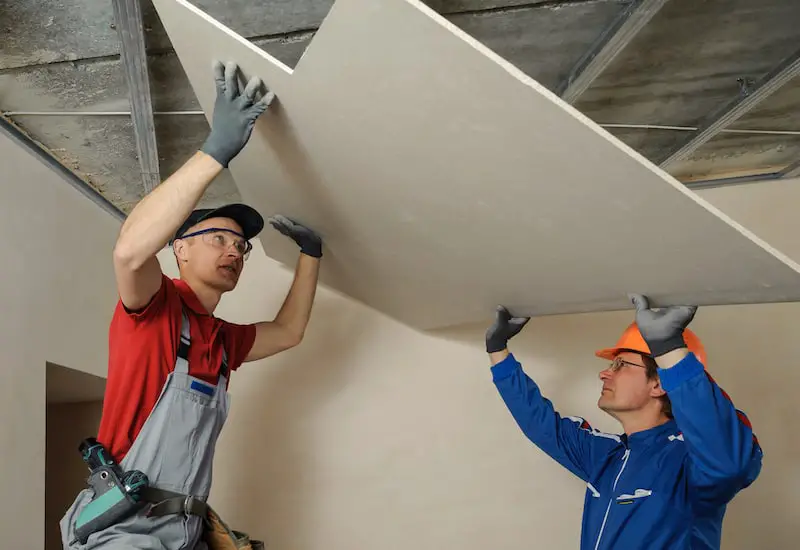
If you have a drywall ceiling, an additional layer of drywall will do wonders for soundproofing. While one layer of drywall is rarely enough to block out noise, two layers might be sufficient. However, extra drywall won’t be as good as proper soundproofing materials, but it will still help.
Two layers will help absorb and repel sound much better than one from both impact and airborne sounds. It’s especially useful with impact noises because the additional layer helps disperse the vibrations that cause the sound in the first place.
2. Replace With Soundproof Drywall
If you’re really looking for the best soundproofing possible, then you should consider replacing your ceiling with soundproof drywall. Most drywall is very thin and has little to no insulation between the boards, allowing sound to penetrate through your ceiling quite easily.
Soundproof drywall is denser and features additional protection inside the structure. Its primary purpose is soundproofing, and you can overlay additional soundproofing materials to increase its effectiveness.
However, it’s important to note that soundproof drywall is reasonably expensive. Not only does it cost much more per square foot than regular drywall, but you also have to factor in labor costs as well. If you don’t plan to do the whole project yourself, it may become prohibitively expensive.
Also, you’re going to need your landlord’s permission to tear down your ceiling and replace it with soundproof drywall. You obviously won’t have to worry about this if you live alone, but you may still need a construction permit if the project is extensive enough.
3. Insulate the Ceiling
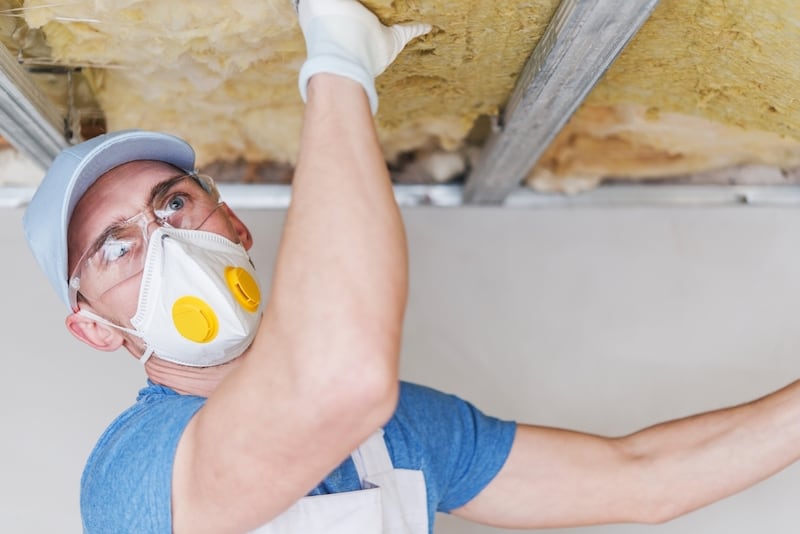
If you can, insulating your ceiling is a great and inexpensive way to improve your soundproofing. You can insert insulation below your neighbor’s floor above the drywall that makes up your ceiling.
Insulation is exceptional at absorbing airborne noise and is also efficient for impact noise, albeit to a lesser extent. If your primary complaint is impact noise, you can use insulation to complement other types of soundproofing.
However, insulating your ceiling only works if you have drywall or fiberglass ceiling panels. Dropped or suspended ceilings often have too much getting in the way of insulation for them to be effective.
4. Decouple Your Ceiling
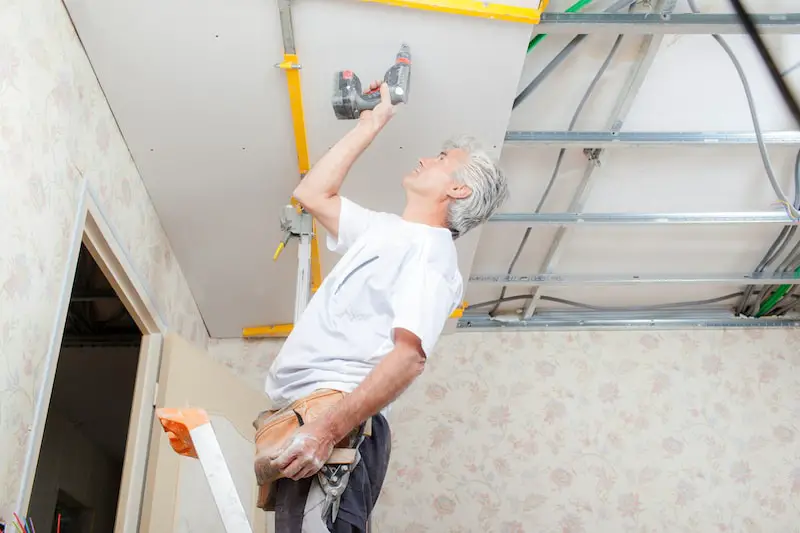
Decoupling your ceiling (also known as a suspended ceiling) is the process of separating the panels that make up your ceiling from the floor above. Sound travels through the structure, meaning when your ceiling is connected to their floor, you’ll hear and feel sounds more intensely.
To decouple your ceiling, you need to install insulation between the drywall, along with a hat channel and a series of sound-resilient clips (also known as whisper clips). These help absorb vibrations from impact noise and also help disperse sound waves from airborne noise.
By separating your ceiling from the floor, you eliminate a pathway for sound to travel. This helps keep not only your living space quiet but your upstairs neighbor’s as well.
Keep in mind that decoupling is an invasive version of ceiling soundproofing. You need to get permission if you don’t own your home before you jump into this project.
5. MLV Panels
- Premium Quality Material [PVC based not EVA]: These vinyl sheets are made in the US...
- The Perfect Solution: Whether for walls ceilings, ducts or pipes, studio projects,...
- Safety Comes First: The TMS soundproofing material contains no re-grinded or recycled...
Mass Loaded Vinyl (MLV) panels are designed to reduce noise from impacts or airborne soundwaves. Many professionals use them when trying to soundproof space and are highly effective insulators for your ceiling.
MLV is a combination of various soundproofing materials, such as vinyl and barium sulfate. It’s incredibly dense despite being relatively lightweight, providing the best results for any soundproofing project.
To install MLV panels, all you need is a spray adhesive or whisper clips to keep the panels in place. You can also use nails or screws, but this method takes longer and is generally more invasive.
MLV panels can be expensive but also might be less than it would cost to physically alter your ceiling space for soundproofing. They’re also removable, meaning you don’t have to worry about risking your security deposit.
The best soundproofing involves MLV panels layered on top of other soundproofing materials, like soundproof drywall. Combining MLV with other soundproofing methods is guaranteed to produce the results that you’re looking for.
6. Temporary Sound Deadening Blankets
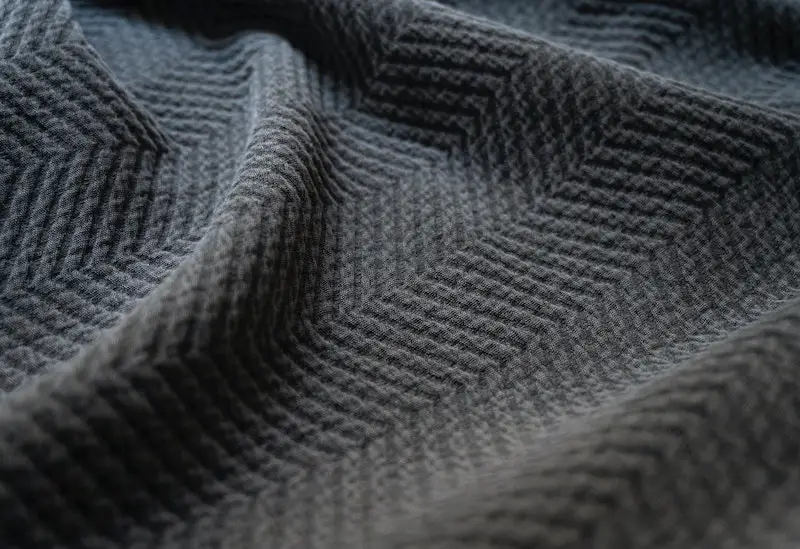
Sound deadening blankets are great solutions for soundproofing, especially if you don’t have the time or resources to completely change your ceiling’s setup. They’re cheap and effective and are often the preferred temporary solution for soundproofing professionals.
To install temporary sound deadening blankets, all you need to do is hang a few lines or railings just below your ceiling. Then, drape the blankets across the line so that it covers the ceiling’s surface area.
While this solution might slightly intrude on your living space, you’ll notice the difference in sound immediately after installing the blankets. You can keep them up for as long as you like, and they’ll help block sound from both your apartment and your upstairs neighbor’s.
This is a good soundproofing method if you don’t have your landlord’s permission to alter your ceiling. Since it’s non-invasive, you generally don’t need to ask your landlord for approval in the first place. You can see how well soundproofing works without committing to the drastic changes that other methods require.
For more information, check out our guide here on how to soundproof a room with blankets.
7. Soundproof Your Walls
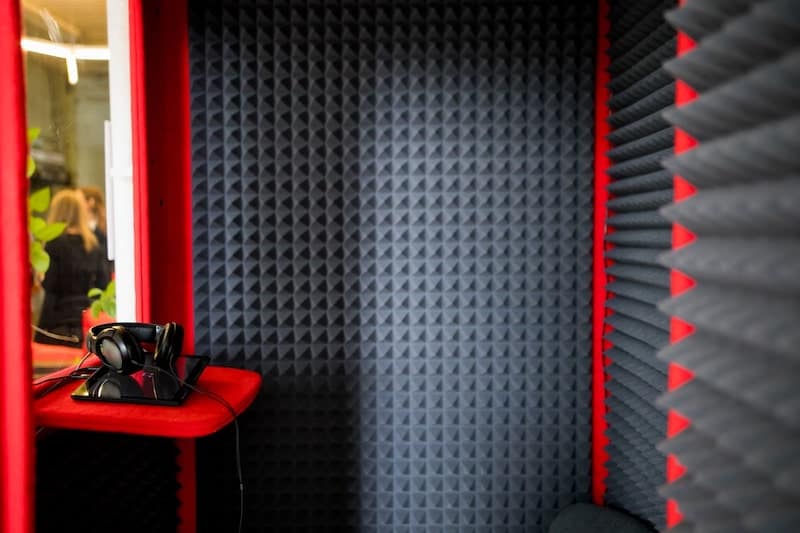
Since sound bounces off the surfaces in your home, you might want to consider soundproofing your walls in addition to your ceiling.
Any noise, especially from heavy impacts, will vibrate, penetrate the ceiling, and travel to the other walls in your living space. By soundproofing your walls, you can reduce the distance sound can travel and absorb any soundwaves that make it past the ceiling.
You can use MLV panels, acoustic foam panels, extra drywall, or large, heavy blankets on your walls to improve their soundproofing.
Again, better to check with your landlord first before you start tearing down your walls for soundproofing.
8. Ask Your Neighbors to Soundproof Their Floor
If you ask nicely, almost anything is possible. While some neighbors might gasp at the thought of doing anything to increase your comfort level, others might be open to the idea of soundproofing their floor.
At the risk of sounding obvious, their floor is your ceiling, so any soundproofing they do will have a direct impact on how much you can hear from their apartment. Offering to help your neighbor soundproof the floor while explaining how easy it can be might tip them in the right direction.
There are plenty of ways your neighbor can soundproof their floor, similar to how you would soundproof the ceiling. Laying down MLV panels, acoustic underlayments, heavy rugs, and carpeting are all great ways and often relatively inexpensive.
If you soundproof your ceiling and your neighbor soundproofs their floor, you could both have a party at the same time, and the other wouldn’t even notice.
Summing up
Anyway, that’s it for our guide to soundproofing a ceiling, we hope it helps you to know what to do with yours.
Although there’s a lot to do and some of the tips will take more work than soundproofing other rooms in your home, it’s well worth the effort as we know firsthand how annoying noise from above can be.
Good luck!

